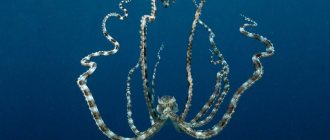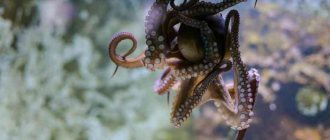Home page Wildlife Animal world
132 467 4.4 16
Scientists do not give a definite answer to the question of how long jellyfish live. Many agree that the life cycle of these animals is short and the life expectancy of most species is from two to six months.
Recently, zoologists discovered that among representatives of this species there are specimens that never die and are always reborn. That is why the Turitopsis Nutricula jellyfish is considered to be the only immortal creature on the planet.
Jellyfish description
The jellyfish has a gelatinous and sometimes almost cartilaginous body in the shape of a rain or lady's umbrella with a stem extending downwards or a bell with a tongue hanging down. Jellyfish has very beautiful photos - but it’s better to watch the video. Jellyfish fascinate with their beauty and smooth movements. The jellyfish is a truly beautiful and worthy animal.
In a jellyfish umbrella, you can distinguish a convex outer or upper side and a concave inner or lower side. From the center of the lower surface of the jellyfish's umbrella, either a very short or rather long stalk extends downwards, representing an oral tube; on the lower edge of this tube there are projections of various sizes located around the mouth opening, which are called oral lobes or oral tentacles.
The edge of the umbrella, equipped on its lower surface with a layer of muscles that serves to reduce the cavity of the bell and at the same time for the movement of the jellyfish, appears either dissected into separate blades, or has the form of a border running in the form of a ring perpendicular to the oral tube. Along the edge of the bell there are usually tentacles or lassoes, the number of which varies greatly; visual, auditory, and sometimes olfactory organs are also located right there.
What are the most beautiful jellyfish you will learn from the video:
The stomach of the jellyfish, communicating through the pharyngeal tube with the mouth, passes into a whole series of radiant canals or elongated pockets leading to the edge of the bell. Eggs and seminal cells develop in the stomach or on the walls of the canals extending from it.
How and what does it eat in the sea?
Jellyfish are coelenterate and invertebrate creatures. This means that they are deprived of some specialized organs, including excretory organs. Food enters through the mouth, is digested here with the help of glandular cells, and the remains are excreted back in the same way, that is, in a vicious circle - through the mouth.
What is included in their diet? These are predators, they eat small sea creatures :
- Worms;
- Plankton;
- Caviar;
- Pisces;
- Crustaceans;
- Sometimes even weaker brothers.
In this they are helped by tentacles equipped with stinging poisonous cells that paralyze the victim. They put food into their mouths.
Different jellyfish have different hunting tactics. Some species pass water through themselves like a filter, leaving what is needed. Others wait for the prey to swim up and grab it.
A short message about jellyfish
Jellyfish live primarily in the ocean, but they are not actually fish, but plankton. These plants and animals either float in water or have such limited swimming ability that currents control their horizontal movements. Some plankton are microscopic single-celled organisms, while others are several meters long. Jellyfish can range in size from less than 1cm to almost 2m wide, with tentacles up to 30 meters long.
Jellyfish are also members of the class Cnidaria (cnidarians - from the Greek word for "nettle") and the class Scyphozoa (scyphozoa - from the Greek word for "cup", referring to the body shape of the jellyfish).
All cnidarians have a mouth in the center of their bodies, surrounded by tentacles. Cnidarian relatives of the jellyfish include corals, sea anemones and coryphella.
Jellyfish contain about 98 percent water.
If a jellyfish washes up on the beach, it mostly disappears as the water evaporates. Most of them are transparent and bell-shaped.
The body of a jellyfish has radial symmetry, which means that parts of the body extend from a central point, like the spokes of a wheel. Jellyfish have very simple bodies - they have no bones, brain or heart. To see light, detect smells and navigate, they have vestigial sensory nerves at the base of their tentacles.
The body of a jellyfish usually consists of six main parts:
- Epidermis, which protects internal organs
- Gastrodermis, which is the inner layer
- Mesoglea, or middle layer, between the epidermis and gastrodermis
- The gastrovascular cavity, which functions as the esophagus, stomach and intestines all in one
- An opening that functions as a mouth and anus
- Tentacles
An adult jellyfish is an invertebrate coelenterate (plural: medusae) named after the Gorgon Medusa, a mythological creature with snakes for hair that can turn a person to stone at a glance.
After the male jellyfish releases the reproductive cells through his opening into the water, they enter the female's opening and fertilize the eggs. Several dozen jellyfish larvae can hatch at once. They eventually float up in the current and look for a hard surface to attach to, such as a rock. When they attach, they become polyps—hollow cylinders with a neck and tentacles at the top. The polyps later disintegrate into young jellyfish called etherae. After a few weeks, the jellyfish swim away and become mature adult jellyfish.
Jellyfish can live from three to six months.
Eating jellyfish
In many countries, jellyfish are the mainstay of the diet. They are a source of substances necessary for the formation of a full-fledged human body. For example, in China, these animals have been eaten for 1,700 years. Once upon a time they were caught directly in the sea, but after changes in the environmental situation, wild jellyfish became dangerous to health, as they accumulate poisons and toxins. Nowadays, Chinese restaurants serve dishes made from jellyfish grown on special farms.
Not all representatives of this species of sea creatures are edible. The safest jellyfish to eat lives in the Yellow Sea. At the same time, only females are used in cooking. They are boiled and then added to soups, salads or served whole. But only freshly caught jellyfish will be useful and harmless to humans. If it sits for too long, it will begin to decompose and become dangerous to the body.
Besides boiling, there are several other ways to prepare jellyfish. They are pickled, dried and dried. In this case, preparing the dish takes about a month. But in Japan they are eaten raw. Wasabi sauce is offered as an addition to jellyfish. The living creature is served on bamboo leaves.
Scientists believe that jellyfish appeared on Earth before dinosaurs and were able to survive the fall of a meteorite.
Scyphoid jellyfish
Scyphoid jellyfish are found in seas and oceans; they exist in salt water conditions. Creatures can move, with the exception of the sessile jellyfish, which practically does not move.
Basic qualities
Scyphoid jellyfish are representatives of sea creatures from the phylum Cnidaria; they survive both in low-temperature water and in warm reservoirs. There are approximately 200 species in total, they move with the current over long distances, but can move at will. The class of scyphoid jellyfish uses contractions of the dome, so water is actively released and a decent speed develops. The method of movement is called reactive.
Description
Representatives of scyphoid jellyfish are endowed with a dome-shaped body with an elongated configuration or resemble an umbrella; species can be quite large. The scyphoid class includes Cyanea arctica, reaching up to 2 m (diameter). There are many tentacles along the edges of the dome, their length reaches up to 15 meters. Stinging cells are located in this part of the body; they contain toxic substances necessary for protection from danger and obtaining food.
Body parts and how the body works
Scyphoid jellyfish have a simple structure; the mouth is located in the middle concave part of the dome, its corners serve as a transition to the oral lobes. They are needed for the delivery of food; in rooted species they are combined into an organ for filtering and eating plankton. Drawing the body parts helps greatly in studying the structure of the scyphoid jellyfish. In particular, they have a stomach with pockets shaped like four of them. Food moves throughout the body using a system of radial tubules. The exit of undigested particles is realized through the mouth; from the intestines, the remains are returned to the stomach.
The scyphoid jellyfish includes epithelial cells in 2 layers (endoderm and ectoderm). The space is filled with tissue of a jelly-like consistency (mesoglea). Scyphoid jellyfish belong to the type of cnidarians and are distinguished by high recovery abilities. The structure of the scyphoid jellyfish involves a large accumulation of nerve particles; they perceive light and sense balance.
Briefly about the features of reproduction
For millions of years, jellyfish inhabited the ocean floor, but after environmental conditions changed due to the displacement of tectonic plates, they began to rise en masse to the surface of the water and migrate to the seas. Today, animals have literally filled the underwater world. There are so many of them that scientists are afraid that they will displace all other forms of life from their natural habitat.
The inhabitants of the Japanese islands were the first to encounter an invasion of jellyfish. Over the past couple of decades, billions of huge Nemopilema nomura from the order of rootmouths have appeared off the coast of Japan. These giants of the underwater world grow up to 2 meters in diameter and weigh over 180 kg. They not only burn the bodies of people swimming in the water, but also often get caught in fishermen’s nets, causing great damage to industrial fishing. In addition, there are regular reports in the media of giant Nomura sinking small fishing boats and pleasure boats by becoming entangled in the motor blades.
The reason that there are more and more jellyfish around the world every year lies in their rapid reproduction. One adult female produces billions of eggs during its life cycle. Their number corresponds to the sperm produced by the male sex of the animal.
Fertilized eggs develop into eggs. Later, planulae are formed from them, and polyps with small tentacles appear from the planulae. Micro-jellyfish use them to catch plankton until they become sexually mature. Afterwards their diet changes. While the polyp is growing, it moves. Behind it stretches a trail of mucus, in which cells remain, which over time turn into new planulae, and then into full-fledged animals.
Due to the fact that an adult jellyfish lays millions of planulae and almost every fertilized larva survives and gives birth to new ones, the population of these creatures is growing at a tremendous rate.
The main stages of life and the appearance of new individuals
There are only two phases, so the life cycle of scyphoid jellyfish is divided into asexual existence and a period when reproduction is possible. They are heterosexual, the life cycle of scyphoids includes the development of germ cells, they come from the endoderm and mature in the stomach area (special folds are provided).
Scyphoid reproduction occurs in aquatic conditions. Scyphoid jellyfish reproduce by releasing eggs and sperm through the mouth; after fusion in the water, a blastula is created. A planula (larva) grows from it.
Scyphoid jellyfish reproduce after fusion: the larvae themselves attach to the substrate and form polyps capable of budding. Their dimensions are within a few mm. Next, the scyphoid jellyfish becomes covered with constrictions; the division process is called strobilation. A stack of individuals (ethers) is formed, they are attached to the strobile (central trunk). Gradually they break away and begin an independent life.
Is it possible to keep them in an aquarium and what to feed them?
Until recently this would not have been possible. Animals died in ordinary aquariums. But progress does not stand still. Carousel-type aquariums or “jellyfish tanks” appeared on the market. The principle of their operation is based on the fact that water does not stand still, but constantly rotates. In such a device, this creature has the ability to hang on the stream, not sink to the bottom and not float up.
The main thing that breeders should know about jellyfish is:
- That the flow speed should be comfortable for animals so that they do not sink or float;
- That there should be no aeration here. Air bubbles can harm the inhabitants; they accumulate under the dome body and are thrown upward.
You need to feed your pets a variety of foods. For this purpose, special vitamin supplements are used. You can take minced seafood from the store and pour it into the water.
Life cycle of a jellyfish
The life cycle of a jellyfish includes the formation of a polyp, then a jellyfish, then a polyp again, and so on. As for the polyp, it differs from the jellyfish in the absence of a bell. Each polyp appears as a sac-like body, closed at one end; the closed lower end of such an individual is attached to some foreign object or to a polypnik, which sometimes floats freely or is attached to something.
The opposite end of the polyp is usually elongated in the form of a cone and in the center has an opening called the mouth, surrounded by tentacles. If we imagine that such a polyp, having separated from the object to which it was attached, will somewhat flatten in the dorso-ventral direction, then we will get a disk with tentacles along the edges and a mouth cone in the middle. From here it is not far to a real jellyfish: all that remains is for this disk to become convex and take the shape of a bell or an umbrella.
Life cycle of a jellyfish
Thus, the oral canal of the polyp turns into the pharyngeal tube of the jellyfish, and the edge of its oral disc, bordered by tentacles, into the edge of the bell of the jellyfish with its tentacles.
As for the bag-shaped stomach of the polyp, it turns into the vascular system of a jellyfish in water in the following way: its close walls grow together along the periphery over some distance, resulting in radially located channels. However, polyps differ from jellyfish not only in their structure, but also in other features, the most important of which is their different participation in the reproduction process. I wonder what jellyfish eat.
Features of character and lifestyle
Photo: Pink jellyfish
Since individuals practically cannot resist sea currents, researchers classify them as representatives of plankton. They can swim against the current only by folding themselves into an umbrella and pushing water out of the lower part of the body through muscle contraction. The resulting jet pushes the body forward. Some species attach to other objects to move. The bags located along the rim of the bell act as a balancer. If the torso falls on its side, the muscles for which the nerve endings are responsible begin to contract and the body is aligned. There is not much to hide in the open sea, so transparency helps to camouflage well in the water. This helps you avoid becoming prey to other predators. Organisms do not hunt people. A person can only be harmed by jellyfish when they wash ashore.
Interesting fact: Jellyfish can regenerate lost body parts. If they are split in two, both halves will survive and regenerate into two identical individuals. When the larvae separate, the same larva will appear.
The life cycle of animals is quite short. The most tenacious of them live only up to one year. Rapid growth is ensured by constant food consumption. Some species are prone to migration. Golden jellyfish that live in Jellyfish Lake, connected to the ocean by underground tunnels, swim to the east coast in the morning and back in the evening.
Jellyfish feeding
Jellyfish feed on animals, because the jellyfish is a predator. It captures small crustaceans, plankton, and small fish. The diet of jellyfish is very varied and mainly depends on the place where the jellyfish lives. If there is no fish there, then the jellyfish won’t get it for lunch. The jellyfish's mouth is located directly under its "cap" or under its umbrella. The jellyfish shoots stinging cells at the victim and paralyzes it.
After this, it moves it into the mouth, and then begins to digest; everything that is not needed or cannot be digested is thrown into the water through the mouth. Some jellyfish can eat other jellyfish, even those of the same size. Sometimes the jellyfish eats the larvae and eggs of important seafood products such as oysters and shrimp. Many jellyfish are considered ocean filters. Since they can swallow sea water and eat everything that is there - process small animals and even garbage.
Jellyfish are carnivores - they eat other animals. The smaller jellyfish feeds on algae and other tiny plankton called zooplankton. Large jellyfish eat crustaceans and other large aquatic animals. They don't look for people to attack - their nervous systems are too simple to do that. Their bite is a defense mechanism and a way to capture their prey.
Each jellyfish tentacle is covered with thousands of cells called clinoblasts, which contain nematocysts containing stinging filaments. When the jellyfish collides with another object, the pressure inside the nematocyst causes the threads to unwind. The stinging cells shoot out at the unwitting victim like tiny darts, releasing poison into them.
Jellyfish venom is a neurotoxin designed to paralyze the jellyfish's prey. Although a jellyfish can kill small aquatic animals, its sting is not usually fatal to humans. But it can cause pain, skin rash, fever and muscle spasms. The degree of pain and reaction to a jellyfish sting can depend on the species—larger jellyfish have larger clinoblasts that can penetrate deeper into the skin, and some jellyfish have stronger venom than others.
When you're at the beach, watch out for jellyfish in both the water and the sand. Even a tentacle that has been separated from a jellyfish can sting. If you are stung, first remove any tentacles stuck to the skin. Do not wash the area with fresh water - the water will help the jellyfish release more venom into your body. Instead, wipe the bite area with alcohol, ammonia, vinegar, or urine (yes, you read that right). You can also use a mixture of baking soda and water. Any signs of an allergic reaction (shortness of breath, hives, swelling) require immediate medical attention.
Stinging cells
The greatest interest among scientists is the mechanism of protecting the jellyfish from enemies and the extraction of food. These processes are carried out with the help of cnidocytes - stinging cells containing a specific organelle that shoots spikes at the target, pierces the prey and injects its toxic contents inside, which has a paralyzing effect on the victim.
However, this is only a general mechanism of action, and there are about three dozen specific types of cnidocytes. For convenience, they are divided into several groups:
- stenoteles or penetrants (piercing) - pointed threads that inject a burning substance;
- isorchises or glutinants (adhesive) - long threads with sticky surfaces that immobilize the victim;
- Desmonemas or volvents (loop-shaped) are lath-like threads that entangle prey.
Some jellyfish have only one type of cnidocyte, while others contain a combination of several types. The stinging cells inject a small amount of poison, but it is very toxic. In most species it is not dangerous to humans for two reasons:
- species specificity (the poison has a strong damaging effect on the usual prey of jellyfish, but is low toxic for mammals);
- the adaptability of the spines to hitting only small targets (the cnidocyte is not capable of piercing human skin).
However, the sea wasp, gonionema, hairy cyanea, Portuguese man-of-war and some other species pose a mortal danger to humans.
Protecting a jellyfish from predators and vice versa
Jellyfish have excellent defenses against predators: their stinging tentacles are a strong deterrent, and their transparent bodies help them hide. Several animals such as sea turtles and some fish species eat jellyfish. Some young fish actually even live inside jellyfish. They hide in tentacles to avoid being eaten by predators until they mature. And some people—especially in China and Japan—also eat jellyfish, considering them a delicacy.
Other than their occasional stings, jellyfish are generally not a nuisance. But in recent years, some parts of the world, namely Japan, Australia and Europe, have seen a problematic increase in jellyfish populations. Scientists believe the increase in jellyfish numbers may be due to additional nutrients in the water, climate change or fishing along the coastline. A dramatic increase in the jellyfish population is called a bloom.
Some researchers are concerned that increasing numbers of jellyfish could compete for food resources with fish and other marine animals, and ultimately outcompete native species. In large numbers, jellyfish also wreak havoc on the local fishing industry, creating holes in fishing nets and destroying other fish populations.
Population and species status
Photo: Giant jellyfish
For all sea inhabitants, pollution is a negative factor, but this does not apply to jellyfish. Recently, the animal population in all corners of the planet has been growing non-stop. Scientists from the University of British Columbia observed the increase in the number of creatures in the World Ocean.
Researchers have observed 138 species of jellyfish since 1960. Naturalists collected data from 45 of the 66 ecosystems. The results showed that in 62% of territories the population has increased significantly recently. In particular, in the Mediterranean and Black Seas, the northeastern coast of the United States, the seas of East Asia, the Hawaiian Islands and Antarctica.
The news of population growth would be more welcome if it did not mean disruption to the ecosystem as a whole. Jellyfish not only cause damage to fisheries, but also cause burns to swimmers, cause disruptions in the operation of hydraulic systems, and become clogged in the water intakes of ships.
In the Pacific archipelago of Palau, in the Jellyfish Lake, with an area of 460x160 meters, there are about two million golden and lunar species of gelatinous creatures. Nothing interferes with their development, except for those who like to swim in the jelly-like lake. It is impossible to determine the exact number, because the reservoir is simply teeming with transparent creatures.
How does a jellyfish reproduce?
Jellyfish are organisms that develop reproductive products; polyps, which are one of the stages of development of jellyfish, the stage of the so-called nurse (since they give rise to the jellyfish themselves), reproduce asexually.
The polyps themselves develop from fertilized jellyfish eggs and are in turn produced asexually by jellyfish. There are, however, jellyfish from whose eggs only jellyfish develop; Polyps are also known that produce eggs and seed cells instead of jellyfish. Between these two extreme cases there are all sorts of transitions. With asexual reproduction, the vast majority of polyps form entire colonies, composed of individual individuals that remain connected to each other; the formation of such colonies is common for the order of hydroid polyps and hydroid jellyfish (Hydroidea). All of the main characteristics of hydroid polyps indicated are also characteristic of freshwater polyps, i.e. hydras.
The sexual generation of hydroid polyps are usually hydroid jellyfish, which are characterized by the presence of a membranous rim, the so-called sail, along the edge of the bell.
There are four main classes of jellyfish
Scyphoid and box jellyfish are two classes of cnidarians that include classical jellyfish; The main difference between the two is that box jellyfish are cube-shaped and bell-shaped, and are slightly faster than scyphoid jellyfish. There are also hydroids (most species of which do not pass through the polyp stage) and staurozoa - a class of jellyfish that lead a sedentary lifestyle, attaching to a hard surface.
All four classes of jellyfish: scyphoid, box jellyfish, hydroid and staurozoa belong to the subphylum of cnidarians - medusozoa.
Hydroid jellyfish and polyps
Freshwater polyps are among the types of hydroid polyps that do not have alternation of generations, i.e., do not develop jellyfish. These same hydroid polyps include the so-called Sarsia, named after a Swedish naturalist; The reproduction of species of this genus is associated with alternation of generations.
The tubular sarsia itself (S. tubulosa) has the appearance of slender and weakly branched bushes, 10-15 mm high; its polyps, club-shaped, are covered with 12-16 tentacles scattered without any order. She lives in the Baltic Sea and settles on the underwater parts of wooden buildings, on sea grass, red algae and similar objects.
What are the most dangerous jellyfish - watch the video:
The club-shaped polyps of Sarsia bud, after a number of changes occurring in them, jellyfish, which are the sexual generation; These jellyfish, reaching 6-8 mm in width, are bell-shaped, equipped with a long oral tube and four long tentacles located along the edge of the bell at an equal distance from one another; At the base of each tentacle a simple eye is placed.
Are Black Sea jellyfish dangerous?
Vacationers at seaside resorts are interested in avoiding any problems and not ruining their vacation. Therefore, the question naturally arises, how dangerous are encounters with such beautiful and mysterious creatures as jellyfish:
• Mnemiopsis and Aurelia can be called harmless organisms; touching them will not harm a person in any way; • a completely different situation can arise when “communicating” with a rootworm; a painful burn is almost inevitable, and traces of it take quite a long time to disappear – several years; • Some people may be allergic to certain seafood when they come into contact with jellyfish.
sailboat
Adjacent to the order of hydroid polyps and hydroid jellyfish just described is the order of floating siphonophores, or tubular polyps (Siphonophora), free-floating colonies, some members of which are in the form of polyps, others in the form of jellyfish; in such colonies there are, in addition, feeding polyps armed with a long thread - a lasso, jellyfish-like individuals that produce egg cells and sperm, and, finally, some members of the colony turn into apparatus or bells that serve for the movement of the colony.
Swallowtail jellyfish
The flat siphonophores include the so-called swallowtail (Velella); this animal, swimming on the sea surface, has a disk-shaped body, pierced inside with air channels, with a crest standing vertically on its upper surface, which plays the role of a sail: on the lower side of the disk in the center there is one large feeding polyp, surrounded by many smaller ones; The tactile members of the colony are located along the edges of the disk.
sailboat
The most famous species of this genus is the common sailfish (Velella spirans), which can often be found very far from the shores, from which it is driven by the wind. In this animal, at the base of small polyps, small jellyfish-like creatures bud, which already develop sexual products and thus serve for the reproduction of the sailfish.
Bubble
Another form, the bladder (Physalia), most of the body of which falls on a huge air sac lying horizontally on the water surface. On the lower surface of the bladder there are large and small feeding polyps, armed with long lassoes; the palps are also located here.
Bubble on the shore - photo
The common bladderwort (Ph. caravella), with purple, white-speckled polyps and a purplish-red air sac, playing the same role as the swallowtail scallop, is distributed in the Mediterranean Sea and the Atlantic Ocean. The dimensions of this form reach 30 cm in length (not counting the lassoes, which can extend very significantly).
Common bladderwort photo
Box jellyfish have tentacles that reach a length of up to 3 meters
nationalgeographic.com
During hunting, the tentacles of these jellyfish become thinner and stretch up to 3 meters in length. From each corner of the box jellyfish's body, which resembles a bell, grows up to 15 tentacles, the length of which can reach 3 meters. Each tentacle has about 5,000 stinging cells, which are activated not by touch, but by the presence of a chemical on the outer layer of the victim.
Types of jellyfish
Akalephs
Representatives of the next order, acalephae meduza, differ from hydropolyps, hydromedusae and siphonophores, which are similar in structure to the polypoid and medusoid individuals of the entire colony, in the structure of both polyps and jellyfish: jellyfish of this order mostly reach quite significant sizes and have an umbrella , dissected at the edges into separate lobes.
As for polyps, their characteristic feature is the presence of four regularly located longitudinal swellings located on the inner wall of their gastric cavity; in the intervals between the indicated swellings there are 4 bags.
Reproduction of Akalephs
In some cases, the egg of a jellyfish develops directly into a jellyfish, but for the most part it turns into a small goblet-shaped polyp with tentacles around the oral disc; on such an embryo, sitting motionless on algae, etc., horizontal ring-shaped constrictions begin to appear, located one below the other; in this form, the entire embryo resembles a stack of plates; soon individual discs - future jellyfish - bud off one after another and, floating freely, turn into sexually mature forms.
Aurelia aurita
The suborder of broad-tentacled acalefs (Semostomae meduza), characterized by the presence of 4 long, boat-shaped simple tentacles located around a cruciform mouth, belongs to the eared jellyfish Aurelia aurita, which is very common in the Baltic and generally in the European seas; it is distinguished by a flat, like a watch glass, and sometimes hemispherical umbrella and narrow, lanceolate, strongly laminated at the edges, but not lobed tentacles.
This form, often found in huge masses, is well known to all explorers of our seas; The size of the eared jellyfish varies between 1 and 40 cm in diameter, but the most common specimens are 5-10 cm.
Hairy jellyfish
Another well-known acaleph jellyfish is the hairy jellyfish (Cyanea capillata), native to northern European seas. Like other species of this genus, the described jellyfish is distinguished by the edge of the bell, dissected into 8 main lobes, and the presence on its lower surface of many long tentacles - lassoes.
The described jellyfish appears in the fall, like the eared jellyfish, in masses - its main color is yellow-brown, sometimes reddish-yellow. It reaches 30-60 cm in diameter, but there are specimens more than 1 m in diameter and with tentacles more than 2 m long.
The northern hairy jellyfish (C. arctica) reaches even larger sizes, that is, over 2 m in diameter; the length of the tentacles of this species sometimes exceeds 4 m. This jellyfish is thus the largest of all jellyfish known to us.
Rootmouth jellyfish
As for root-mouthed jellyfish (Rhizostomeae meduza), they differ from the previous ones in the presence of 8 long, arranged in pairs, root-shaped mouth tentacles. In most cases, these tentacles grow together in pairs, and the mouth is completely closed and its role is played by many small sucking holes located along the tentacles.
Between the indicated stomata, these jellyfish often have more or less numerous oral palps, with button-shaped thickenings at the ends.
Cotylorhiza
An example of such a jellyfish can be the Mediterranean cotylorhiza tuberculata; it is a generally yellowish jellyfish, 10-20 cm wide in diameter with long sucking tubes or with suction cups on long legs; the edges of the disk of this jellyfish are mottled with white spots, the oral disk is fleshy red or yellowish-brown in color; milky-white tentacles, which, however, can sometimes be amber-yellow in color, brown, purple or violet blue, festoons surrounding the sucking holes - these are the features that describe the described jellyfish in more detail.
Disc jellyfish
Both mentioned groups of jellyfish, broad-tentacled and root-mouthed, constitute the suborder of disc-shaped jellyfish (Discomedusae), the characteristic features of which are:
- a flat, mostly disc-shaped bell or umbrella, usually with 8 peripheral sense organs;
- the edge of the bell is cut into no less than 16 blades; the stomach is surrounded by 8, 16, 32, or even a large number of gastric sacs;
- On the lower wall of the stomach there are gonads, which are very clearly visible in our eared jellyfish and are popularly called eyes.
Cuboid jellyfish
The next group of cuboid jellyfish (Cubomedusae) is defined by the following characteristics:
- a tall, cubic umbrella, the edge of which, reminiscent of the swimming edge of hydroid jellyfish, is in the form of a horizontally tense membrane or hanging downwards;
- on this edge there are 4 sensitive flasks, with an eye and an organ of hearing on each.
A representative of this group can be the Mediterranean common box jellyfish (Charybdea marsupialis), which is 2-3 cm wide and 3-4 cm high; this species, as well as other species of the same genus, is interesting for its unusually highly differentiated eyes, the structure of which resembles the structure of the eyes of vertebrates.
Sea wasp jellyfish
The sea wasp jellyfish is the most poisonous jellyfish in the world; it lives off the coast of Thailand and Australia. Its body is glassy and cube-shaped, that is, this jellyfish belongs to the cuboid jellyfish. Its stinging cells leave fatal burns. As a result, death can occur within 3 minutes.
However, there are survivors - people with strong hearts. There is an antidote against sea wasp jellyfish burns, but you must have it with you, since the victim has no more than 3 minutes from the moment of the burn to save a life. Therefore, you should swim only in places specially fenced off from jellyfish; if you decide to swim in the open ocean, then have an antidote with you.
Goblet jellyfish
Finally, the last group of goblet jellyfish (Stauromedusae) is characterized by the presence at the top of the goblet-shaped umbrella of a stalk, with the help of which the jellyfish is attached to algae, etc.; The tentacles, collected mostly in bunches, sit along the edge of the bell of these jellyfish.
Goblet jellyfish - photo
Lantern
The described suborder includes, among other things, the lanternfly (Lucernaria medusa), which belongs mainly to the northern seas; this form can move from place to place with the help of its tentacles, which is also helped by the jellyfish leg, which has the ability to arbitrarily attach or separate from underwater objects.
Photo of lantern jellyfish
In the northern European, as well as in the Black and Baltic seas, the largest (up to 7 cm) and long-known species of the described genus is found - the common lanternfly (L. quadricornis): this gray, green, brown-yellow or, finally, , the black-brown jellyfish willingly settles on red algae. It is also known on the shores of Greenland and found in America, off its northeastern shores.
Watch a video about jellyfish:
Jellyfish do best in their natural environment, but many aquarists have jellyfish tanks. People who capture and breed them in captivity must be very careful not to damage the jellyfish's fragile bodies. It is easier to collect jellyfish at the polyp stage, when they are less vulnerable. Ideally, they should be in an aquarium without any sharp edges or obstacles that could cause injury to them. Additionally, the water must have some flow because jellyfish mostly move with currents.
Irukandji syndrome
Irukandji is a type of box jellyfish found in Australia. This jellyfish is called the "Australian killer jellyfish." Although these jellyfish are small (about the size of a human finger), their venom is extremely toxic. The Irukandji jellyfish has clinoblasts on its body as well as on its tentacles. The sting of this jellyfish is so painful and causes such severe symptoms that scientists have named it: Irukandji syndrome.
Size comparison of Irukandji jellyfish
Irukandji jellyfish in water
Symptoms of Iryukanji syndrome include high blood pressure, vomiting, headaches, severe cramping and burning. Irukandji syndrome can last up to two weeks and there is no antidote. Doctors have found that magnesium infusions may provide some relief, but this jellyfish's sting can be fatal.











